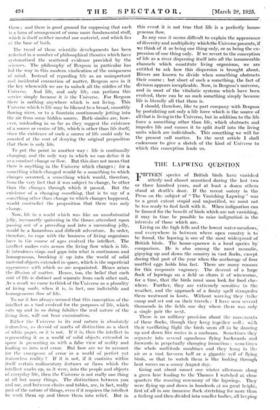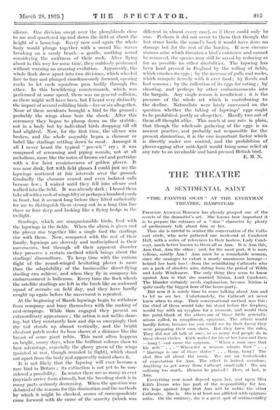THE LAPWING QUESTION F IFTEEN species of British birds have vanished
utterly. and almost unnoticed during the last two or three hundred years, and at least a dozen others. stand at death's door. If the recent outcry in the PresS on the subject of "The Vanishing Lapwing" was to a great extent stupid and unjustified, we must not be tco ready to find fault with it. When indignation can be fanned for the benefit of birds which are not vanishing, it may in time be possible to raise indignation in the interests of those which are.
Living on the high fells -and the lowest water-meadOwa,' and everywhere in between whereopen country is to be found, the lapwing is one of the most wideipread of British birds. The house-sparrow is 'a local species by comparison. He is also among the most nomadic, gipsying up and down the country in vast flocks, except during that part of the year when the anchorage of four - mottled eggs holds him fast. There are many reasons*, for this corporate- vagrancy. The descent of a large, flock of lapwings on a' field so clears it of wireworms, for a time, that the birds must soon look for food else- Where.. Further, they are extremely sensitive to the' weather, and the approach of a frosty spell stampedes them westward in hosts. Without warning they strike camp and set out on their travels : I have seen several thousands in the fields one day where there was only a single pair the next.
There is no military precision about the movements'. of these flocks, though they hang together well : with their vacillating flight the birds seem all to be dancing up and down like motes in a sunbeam. Sometimes they separate into several squadrons flying backwards and forwards in perpetually changing formation : semaimes the whole multitude combines and they hang in the air as a vast far-seen ball or a gigantic veil of flying. birds, so that to watch them is like -looking through heat waves on a sunny August day.
Going out about sunset one winter afternoon along a green lane leading to the Thames I watched at close quarters the roosting ceremony of the lapwings. They were flying up and down in hundreds at no great height, first 'of all in one immense flock stretching for more than a furlong and then divided into smaller bodies-, all keeping" silence. One division swept over the ploughlands close to me and quartered up and down the field at about the height of a -hotiSetop. Every -how and again the whole- body would plunge together with a Sound like waves breaking on a sandy beach—a gentle, soothing sound considering the swiftness of their: rush. After flying about in this Way for some time, they suddenly performed without warning an amazing evolution. Apparently, the whole flock drew apart into two divisions, which wheeled face to face and plunged simultaneously forward, opening ranks to let each squadron pass bodily through the other. In this bewildering countermarch, which was performed at some 'speed, there was no general collision, as there might well have been, but I heard very distinctly the impact of several colliding birds—five or six altogether. None of these accidents brought a bird to the ground ; probably the wings alone bore the shock. After this ceremony they began to plump down on the stubble, not in a body but by individual birds dropping till all had alighted. Now, for the first time, the silence was broken, and the whole assembly began a clamour or babel like starlings settling down to roost. Amongst it all I never heard the typical " pee-wit " cry ; it was composed of screaming and piping sounds, not at all melodious, more like the notes of brown owl and partridge with a few faint reminiscences of golden plover. It was now dusk, but with field glasses I could just sec the lapwings scattered at fair intervals over the ground. Gradually the clamour ceased and even isolated calls became few ; I waited until they fell into silence and walked into the field. It was already dark ; I heard them take off with a rush of wings fifty or perhaps a hundred yards in front, but it seemed long before they lifted sufficiently for me to distinguish them strung out in a long thin line three or four deep and looking like a flying hedge in the twilight.
Starlings, which are companiOnable birds, feed with the lapwings in the fields. When the alarni is given and the plover rise together like a single bird the starlings rise with them. Now, compared with the rest of their family, lapwings are slovenly and undisciplined in their movements, but through all their apparent disorder they preserve a certain method which brings about the starlings' discomfiture. To keep time with the curious • flight of the round-winged hesitating plover is more than the adaptability of the businesslike direct-flying starling can achieve, and when they fly in company his embarrassment is ludicrous. Every time the flock wheels the satellite starlings are left in the lurch like an awkward squad of recruits on field day, and they have hardly caught up again before the movement is repeated.
At the beginning of March lapwings begin to withdraw from company and busy themselves with the making of nest-scrapings. While thus engaged they present an extraordinary appearance ; the action is not unlike danc- ing, but they constantly bow and dip so sweepingly that the tail stands up almost vertically, and the bright chestnut patch under its base shows at a distance like the breast of some giant robin. This most often happens on bright, sunny days, when the brilliant colours show to best advantage, especially the glossy green of the wings (pointed at rest, though rounded in flight), which stand out apart from the body and apparently raised above it. It is not likely that the lapwing will ever become a rare bird in Britain ; its extinction is not yet to be con- sidered a possibility. In winter there are as many as ever (myriads arrive from abroad), but the breeding stock is in many parts seriously decreasing. When the question was debated of the reasons for this diminution and the methods by which it might be checked, scores of correspondents came forward with the cause of the scarcity (which was different in almost every case), as if there could only be one. Perhaps it did not occur to them that though the last straw broke the camel's back it would have done no damage but for the rest of the burden. If new circum- stances arise which threaten a bird's existence and cannot be removed, the species may still be saved by reducing as far as possible its other disabilities. The lapwing has been hard pressed in England by the rolling of fields,. which crushes its eggs ; by the increase of gulls and rooks,. which compete fiercely with it over food ; by floods and bad seasons ; by the collection of its eggs for eating ; by shooting, and perhaps by other embarrassments into the bargain. Any single reason is insufficient ; it is the pressure of the whole set which is contributing to. the decline. Naturalists were lately canvassed on the question whether the taking of lapwings' eggs ought to be prohibited, partly or altogether. Hardly two out of them all thought alike. This much at any rate is plain, that though the wholesale gathering of the eggs is an ancient practice, and probably not responsible for the present diminution, it is the one important factor which is directly under our control, and the prohibition of plover-egging after mid-April would bring some relief at any rate to an invaluable and hard-pressed British bird.
E. M. N.















































 Previous page
Previous page